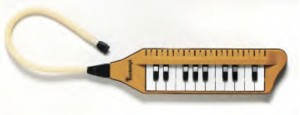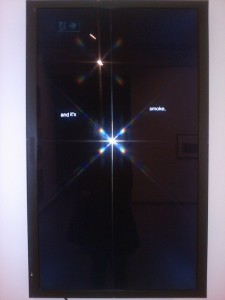Same, same but different or three I liked best
I passed through the sliding doors of MUMA at Monash’s Caulfield campus. How things have changed since I was a student here. We weren’t lucky enough to have this in 1992. Well anyway, as I passed through, the first thing that met my knees, and then my eyes, was a long flat arrangement of objects, mostly tinged with a curio and vintage flavor.
I couldn’t help think of the book I had recently begun reading: AA Gill’s The golden door, a book which describes migration from Europe to America, and more specifically opens with the author describing a museum in Bagshaw, England, and the ‘Edwardian way of things, collected indiscriminately and rigorously, with the global kleptomania of Empire and the desire to calibrate, measure and stuff everything possible’.
Back at MUMA, Patrick Pound had put together a collection of things to do with wind (a.k.a. The museum of air). Why wind? Wind is elementally transient, yet it is always around. It is an invisible force that animates all things through which it passes. It’s actually quite amazing to think of wind that way, as a sort of ineffable force, yet here I was looking at a whole lot of stuff that made wind seem corny and kitsch, like a ’70s pop song or band. I think there was just such a single among the display. It made me smile to see the commonality in the disparity and I smirked at the ‘wind’ jokes and then I thought about themes and the desire to fetishize, to maintain themes in collections. That’s often what people call a hobby. Context is everything, or not?
Context was the thing so purposefully missing from Kit Wise’s recording and transcript of the Hindenburg disaster in the form of a hypnotic and disturbing video text piece missing the almost vital clue of visual footage. A long-gone journalist bears witness to the unexpected and horrific explosion and fire of something, but we know not what. The anachronism of his expression did not dull my empathy for what he had seen and what I could only, at that moment, imagine.
The work I liked most was contained in a dimly lit room. I’ve been to too many What Is Music?-type performances not to love this! Inside were four dot matrix printers, like robots, a quartet! Unwavering and hermetically sealed in glass, programmed to print sound only. Of another decade, old enough to be redundant for their intended purpose but here recontextualized as instruments.
AA Gill suggests that the rarefied and ratified Western European museums of yesteryear are out of fashion. That the purpose of installing a culture of condescension from an Imperialist society imposing its values upon all others it patronisingly considers exotic is redundant and politically incorrect. I’m pretty sure he’s right. Like major international curated exhibitions, Liquid archive gave space for a contemporary collation, contemplation and re-imagining of memory and artefacts of times passed. That seems to be in right now.
Liquid archive, Monash University Museum of Art, Melbourne, 19 July – 22 September 2012.


[The User], ‘Quartet for dot matrix printers’, 2004, four dot matrix printers and personal computers, ASCII text compositions, network server, microphones, sound system, office furniture. [The User] is a Canadian art collective comprised of architect and installation artist Thomas McIntosh, and composer and sound artist Emmanuel Madan